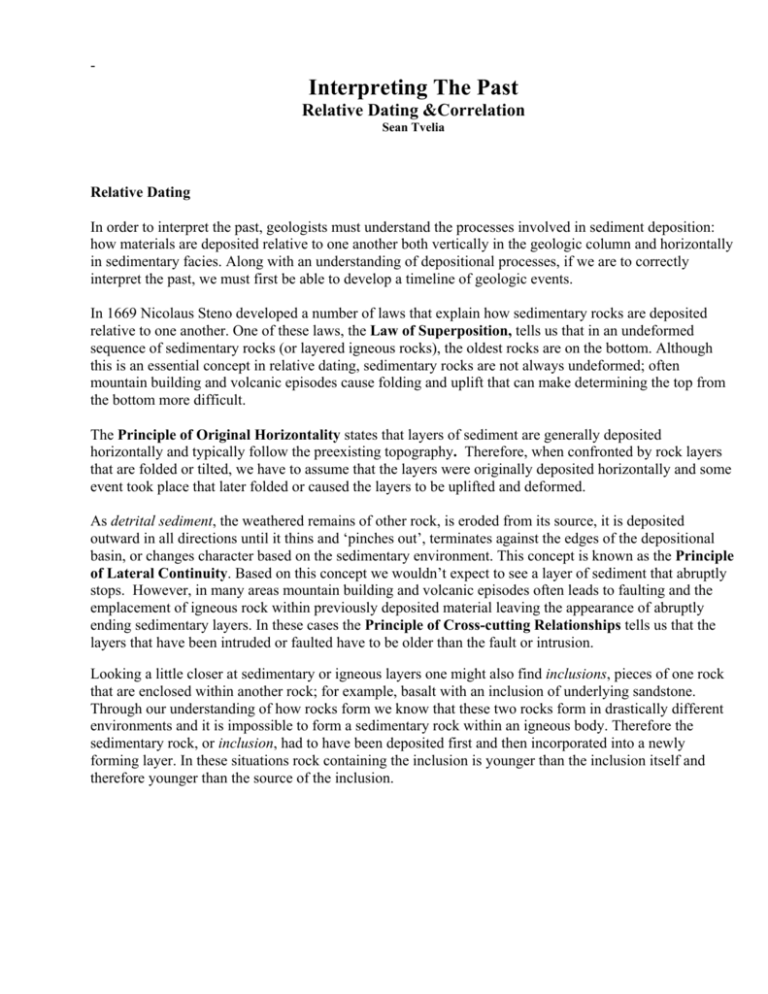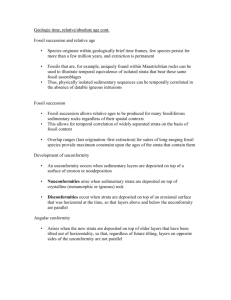Interpreting the Past
advertisement

- Interpreting The Past Relative Dating &Correlation Sean Tvelia Relative Dating In order to interpret the past, geologists must understand the processes involved in sediment deposition: how materials are deposited relative to one another both vertically in the geologic column and horizontally in sedimentary facies. Along with an understanding of depositional processes, if we are to correctly interpret the past, we must first be able to develop a timeline of geologic events. In 1669 Nicolaus Steno developed a number of laws that explain how sedimentary rocks are deposited relative to one another. One of these laws, the Law of Superposition, tells us that in an undeformed sequence of sedimentary rocks (or layered igneous rocks), the oldest rocks are on the bottom. Although this is an essential concept in relative dating, sedimentary rocks are not always undeformed; often mountain building and volcanic episodes cause folding and uplift that can make determining the top from the bottom more difficult. The Principle of Original Horizontality states that layers of sediment are generally deposited horizontally and typically follow the preexisting topography. Therefore, when confronted by rock layers that are folded or tilted, we have to assume that the layers were originally deposited horizontally and some event took place that later folded or caused the layers to be uplifted and deformed. As detrital sediment, the weathered remains of other rock, is eroded from its source, it is deposited outward in all directions until it thins and ‘pinches out’, terminates against the edges of the depositional basin, or changes character based on the sedimentary environment. This concept is known as the Principle of Lateral Continuity. Based on this concept we wouldn’t expect to see a layer of sediment that abruptly stops. However, in many areas mountain building and volcanic episodes often leads to faulting and the emplacement of igneous rock within previously deposited material leaving the appearance of abruptly ending sedimentary layers. In these cases the Principle of Cross-cutting Relationships tells us that the layers that have been intruded or faulted have to be older than the fault or intrusion. Looking a little closer at sedimentary or igneous layers one might also find inclusions, pieces of one rock that are enclosed within another rock; for example, basalt with an inclusion of underlying sandstone. Through our understanding of how rocks form we know that these two rocks form in drastically different environments and it is impossible to form a sedimentary rock within an igneous body. Therefore the sedimentary rock, or inclusion, had to have been deposited first and then incorporated into a newly forming layer. In these situations rock containing the inclusion is younger than the inclusion itself and therefore younger than the source of the inclusion. So far we have discussed most of the ways in which deposited material can be related to one another and dated based on their relative positions, but deposition is only one part of the geologic cycle and if we concentrate on only what we can see then we may miss some key points of the geologic past. In order to recreate the geologic history of any area accurately, we must also be aware of the material we can’t see. Over time weathering and erosion break down rock and transport the resulting sediment to other locations. This process can erase millions of years of geologic history that can never be restored. Changes in climate and/or depositional patterns can also lead to periods of non deposition. These breaks in the rock record are known as unconformities. Although we may never know exactly what material was present before an erosive episode, being able to correctly identify the unconformity will better our ability to correctly interpret the geologic past. There are three major types of unconformities: angular unconformity, disconformity, and a nonconformity (Figure 1). An angular unconformity occurs when strata, tilted by orogenic episodes, are eroded. Subsequent deposition on top of the eroded surface Figure 1. Unconformities then creates newer horizontal strata. A disconformity, also known as an erosional unconformity, occurs when sequences of relatively parallel strata are separated by a physically identifiable erosional surface (a paraconformity, exists when strata are seemingly continuous but missing fossil assemblages demonstrate missing geologic time). Lastly, a nonconformity occurs when sedimentary strata are in contact with either metamorphic or igneous rock. This can occur when sediment is deposited directly over crystalline bedrock or previously metamorphosed rock or even during the emplacement of magma. Understanding the concepts discussed above allows the geologist to properly order geologic events in a given area. However, if we are to accurately interpret the past we must be able to equate strata in local sections to strata in distant sections. Correlation Correlation is the act of determining equivalency between two or more distant lithologic units. This process can be done either lithographically or chronostratigraphically. In Lithographic correlation, units are equated based on Figure 2. Simple lithographic correlation. represented facies. This process does not account for possible differences in the time at which the facies were deposited. Chronostratigraphic correlation involves the identification of different facies that had been deposited at similar times. This can be done through the use of fossil assemblages. Correlation, either litholographic or chronostratigraphic, can be a very simple or a very complex process. In its simplest form this process can involve simply matching up identical facies from two different locations, as shown in Figure 2. However, the sediments that produce sedimentary rock are often deposited parallel to each other at similar times creating sedimentary facies. If we forget this fact and simply match similar units, we would make a drastic error in our interpretation of the past environment. Furthermore, there are many geological circumstances that may result in one unit being found at one locality and being completely absent at another locality. Because of this it is often necessary for us to make interpretations with very little evidence. The first thing to remember when correlating local sections is that in many examples there will be no one single right answer. Instead, there may be three or four possible solutions all of which need to be critically analyzed. The principle of multiple working hypotheses states that when confronted with a problem, it is best not to use the first solution that comes to mind but critically examine the problem from many perspectives. Once the problem has been analyzed, only then can one make a list of all possible solutions regardless of how unlikely they might seem. Figure 3. Facies change in two local sections due to changes in depositional environment. Once you have a list of possible solutions another principle takes over. This principle is commonly known as Occam’s Razor. This principle simply states that when confronted with a number of solutions the simplest solution is always preferred. In science this is most often referred to as the KISS Principle (Keep It Simple, Stupid). Simple Lithographic Correlation This section is titled simple lithographic correlation because it is just that, simple. In most cases facies found in one local section are also found in other local sections. However, there are situations where, due to geologic circumstances, rock type changes from section to section. This is most commonly seen in the transition from one sedimentary facies to another. In cases where a rock unit is present in one local section but not in another, there may be two causes. The first cause is simply a facies change. This is caused by the different depositional environments that exist in many areas. In these cases the rock unit Figure 4. Depicting a pinchout is not missing but has simply changed character as demonstrated between local sections in Figure 3. The only rule to the use of facies changes in correlation is that you may not insert two facies changes between local sections. The second cause of an absent unit may be pinchout. This is caused when a rock unit simply diminishes in thickness across the distance between the two sections until it eventually “pinches out” before reaching the second section (Figure 4). Relative Dating and Simple Geologic Histories For each of the following examples place the labeled strata in correct age order from oldest to youngest. Label and identify any unconformities. Example 1 Youngest _____ _____ _____ _____ _____ _____ _____ _____ _____ Oldest _____ Example 2 Youngest _____ _____ _____ _____ _____ _____ _____ _____ _____ _____ Oldest _____ Questions: 1. In Example 1, Layer E represents a layer of the igneous rock basalt. Based on the rules of relative dating discussed in this lab, determine whether this layer is a lava flow or a sill created by igneous intrusion. Explain your answer. 2. Using the relative dating scheme developed in Example 1, your knowledge of sedimentary rocks, and the key above, develop a geologic history of the area represented by Example 1 3. If Layer B in Example 2 also represents a layer of basalt, determine whether this layer is a lava flow or a sill created by igneous intrusion. Explain your answer. 4. Using the relative dating scheme developed in Example 2, your knowledge of sedimentary rocks, and the key above, develop a geologic history of the area represented by Example 2. Correlation For each example given, show two different correlation possibilities using simple lithographic correlation. To show correlation, draw lines connecting the bases of equivalent strata. Then determine which correlation scheme is more likely and explain why. Example 3 Correlation 1 Correlation 2 Correlation 1 Correlation 2 Explanation: Example 4 Explanation: For the following example use the concept of facies changes to create two possible correlations of the local sections. Then determine which correlation scheme is more likely and explain why. . Example 5 Correlation 1 Correlation 2 Explanation: Example 6 In this example use the Fossils that have been identified in the strata to correlate the two columns. Identify any unconformities with a line to represent missing time and give a brief explanation of how the sections could have formed. Example 7 In the following example use the concepts of pinchout and facies change to correlate the three sections and answer the following questions. A. Describe what is happening to the limestone unit in the columns A, B, and C and determine a possible reason for these observations. B. The numbers to the left of column A represent distinct time frames. Analyze the three columns and determine what was happening to sea level from time 1 to time 3. Use the lithographic evidence to explain. C. Which of the three columns was deposited closest to land? Explain your reasoning.






